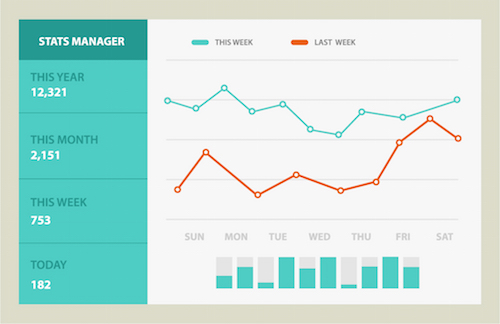
First-time founders or entrepreneurs in early stage startups may be unsure of what to write in their updates to investors. How much or how little should you include? What details are important and what details are unnecessary? In this post, Kevin Dick shares the minimum updates you need to update your investor.
Kevin Dick is Managing Director at Right Side Capital Management. He's a 3-time founder, book author, and holds 11 patents.
The article "Minimum Viable Investor Updates" originally appeared on Kevin's website. It has been republished below with permission.
In my opinion, useful investor updates have three requirements:
1. They must get done
2. They must be easy to produce
3. They must be easy to consume.
Anatomy of an Update
You can deliver on all three requirements by breaking updates into modules and putting the most important modules first. That way, you need only produce the modules you have time for and we need only consume the modules we have time for. Everybody wins.
Here are the modules and order I recommend:
[Company Name] Investor Update for Month Ending [Last Day of Month]
- Metrics
- Highlights (Optional)
- Asks (Optional)
- Thank Yous (Optional)
- Commentary (Optional)
Notice that the only required module is “Metrics”. This should be easy to produce because, at any given moment, you should have a handful of Key Performance Indicators (KPIs) you track anyway. This should be easy to consume because most investors have lots of experience absorbing tabular business data. This should be easy to get done because, in our modern software-driven world, KPIs are at your fingertips. Most importantly, if they are the metrics you are actually tracking to run your business, then they will be reasonably informative to investors. Requirements satisfied!
More detail on metrics in a minute, but first some quick notes on Highlights, Asks, and Thank Yous. If you opt to include these modules, do them as bullets. Easier to produce and easier to consume. But, as with PowerPoint slides, no more than 7 bullets per section! Even then, only go to 7 on rare occasions. No more than 5 most of the time. It’s easy for people to get saturated and when they get saturated, they flush theentire list from their attention. If you’ve got more to say, put it in the Commentary.
Everything after Metrics really is optional. Better to get the update out the door quickly than wait until you come up with points for every section. If you ever find yourself thinking something like, “I’ll crank out the Asks later,” stop! Just hit send. Then if you do think of important items later, put them in a notes file and include them in the next update. Or send out a specific Asks email.

Universal Metrics
Now for some depth on metrics. There are really two types: (1) those that are universal to all pre-seed/seed startups and (2) those that are particular to your business. Investors need both. The first type gives us a general sense of how things are going for you relative to the typical startup lifecycle. Kind of like the vital signs that all doctors want to know regardless of patient or condition. They help us triage our attention. So start with them:
- Revenues: [revenues | date when you plan to start selling] (+/- ?% MoM)
- Total Expenses: [expenses] (+/- ?% MoM)
- Net Burn: [total revenues – total expenses] (+/- ?% MoM)
- Fundraising Status: [not raising | planning to raise | raising | raised]
- Fundraising Details: [how much, what structure, valuation/cap, who]
- Ending Cash: [last month’s Ending Cash – this month’s Net Burn + this month’s Amount Raised] (+/- ?% MoM)
- Full Time Employees: [FTEs, including founders] (+/- # MoM)
Note 1: We strongly encourage a monthly update cycle. Anything longer means we get data that’s too stale. Anything shorter, and the financial metrics don’t really make sense. Though if you’re part of an accelerator that encourages weekly updates, we’d love to see them. Just make sure we also get the monthly metrics!
Note 2: Always put the percentage or absolute month-over-month changes in parentheses next to each entry. It turns out that highlighting the deltas make updates dramatically easier for us to absorb by drawing immediate attention to the most volatile areas.
A couple of quick explanations. Always have a Revenues line. If your product isn’t finished or you aren’t actively trying to generate revenues, just put the target date for when you do plan to start selling. Either piece of information is enormously helpful to us. Also, provide an FTE number that logically reflects the labor resources at your disposal. A full time contractor is a unit of full time labor that you can call on. Two half-time employees are also one unit. An intern may or may not be a unit or fraction of a unit depending on how much time he/she is putting in and whether the output is roughly equivalent to what a regular employee would produce. Don’t exclude people based on technicalities, but don’t pad your numbers either.
Now, some detail about fundraising status. This topic turns out to be pretty important to existing investors. First, it lets us know that you’re on top of your working capital needs. Second, some investors like to participate in future rounds and even the ones that don’t are a great source of warm leads. Third, it makes us feel good to know that other people have or will be validating our previous investment. Here are a couple of example fundraising bullets:
- Fundraising Status: planning to raise in 4Q2015
- Fundraising Details: $750K – $1M Series Seed at a $5M-$6M pre-money from a small fund and/or local angels
- Fundraising Status: raising
- Fundraising Details: $300K – $500K on a convertible note at a $2.75M cap with $175K soft committed from [prominent angel name] and other local angels
- Fundraising Status: raised and raising
- Fundraising Details: $400K closed of a $600K convertible note at a $4M cap from [small fund name], [AngelList syndicate name], and local angels.
Custom Metrics
At any point in time, there should be a handful of top-level KPIs that you monitor to help run your particular startup. Of course, they vary across lifecycle stage, technology area, and business model. Just pick the most important 2-6 and give them to us. Feel free to change them as you pivot and mature.
Here’s an example for a pre-product enterprise SaaS company:
- Projected Alpha Delivery Date: 11/30/2015 (+15 days)
- Alpha Access Wait-list: 47 Companies (+8)
And one for an enterprise SaaS company that recently shipped private beta:
- Max Queries/Minute: 1,201 (+29% MoM))
- Outstanding Critical Bugs: 3 (-2)
- Inbound Inquiries: 481 (-17% MoM)
- Qualified Prospects: 19 (+2)
- Paid Pilots: 3 (New Metric!)
And finally one for a consumer Web company in full operation:
- Max Concurrent Users: 1,006 (+30% MoM)
- Registered Users: 23,657 (+13% MoM)
- Monthly Actives: 3,546 (+4.5% MoM)
- Users Making Purchases: 560 (+21% MoM)
- Total Purchase Value: $17,993 (+28% MoM)
- CAC: $12.55 (-7% MoM)

That’s it. We estimate that, if you keep your accounting system up to date and use MailChimp, producing an update with metrics and a few extra bullets should take about 15 minutes (with some practice). And you’d be heroes in our book. Well, all entrepreneurs are already heroes. So you’d be superheroes!




